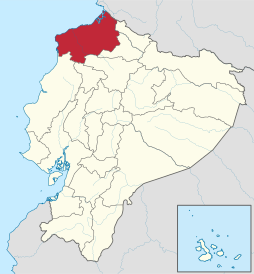
The Ecuadorian Civil War of 1913–1916, or Concha Revolution, was a civil war fought in Ecuador in the 1910s. It began in 1913, when the Esmeraldas Province rose up against the rule of Leónidas Plaza. Ultimately, the government was able to re-assert control, though much of the province was destroyed in the process. [1]
The Civil War
The civil war was an outcome of the assassination of liberal
Ecuadorian leader
Eloy Alfaro -- responsible for the
Liberal Revolution of 1895 -- on January 28, 1912, in
Quito.
[2]
[3] In the north of Ecuador, the citizens of
Esmeraldas, especially the
Afro-Esmeraldans, were loyal to the
liberal cause and the ensuing struggle left many of the poorly armed blacks dead at the hands of government troops.
This uprising in support of Alfaro was against a more conservative wing of the Liberal party. Ecuadorian blacks contributed notably to the military effort and even formed the bulk of Alfaro’s army in the region. The Esmeraldan rebel army was led and funded by Colonel
Carlos Concha Torres (1864–1919). This civil war left a bitter legacy in the region.
While the authors of Resort to war: a data guide to inter-state, extra-state, intra-state, and non-state wars, 1816-2007 state that the war ended in 1914, [1] Paul Henderson states that it ended in 1916, when Carlos Concha was captured and held prisoner in Quito until his death in 1919. [4]
References
- ^ a b Sarkees, Meredith Reid; Wayman, Frank Whelon (2010-07-01). Resort to war: a data guide to inter-state, extra-state, intra-state, and non-state wars, 1816-2007. CQ Press. p. 392. ISBN 9780872894341.
- ^ Maloney, Gerardo F. (1995), “El negro y la cuestión negro”, Nueva historia del Ecuador; Editor, Enrique Ayala Mora; 13 vols; Quito, Ecuador: Grijalbo
- ^ Foote, Nicola (2008), Entry: “Esmeraldas”, Encyclopedia of the African Diaspora: Origins, Experiences, and Culture, Vol 1; Editor, Carole Boyce Davies; Santa Barbara, California: ABC-CLIO; pp. 422–423
-
^ Henderson, Paul (1997). "Cocoa, Finance and the State in Ecuador, 1895-1925". Bulletin of Latin American Research. 16 (2): 178.
ISSN
0261-3050.
JSTOR
3339105.
in a nation-state as fragile as Ecuador, insurrections, border disputes and even civil war (1912-1916) were not uncommon.

The Ecuadorian Civil War of 1913–1916, or Concha Revolution, was a civil war fought in Ecuador in the 1910s. It began in 1913, when the Esmeraldas Province rose up against the rule of Leónidas Plaza. Ultimately, the government was able to re-assert control, though much of the province was destroyed in the process. [1]
The Civil War
The civil war was an outcome of the assassination of liberal
Ecuadorian leader
Eloy Alfaro -- responsible for the
Liberal Revolution of 1895 -- on January 28, 1912, in
Quito.
[2]
[3] In the north of Ecuador, the citizens of
Esmeraldas, especially the
Afro-Esmeraldans, were loyal to the
liberal cause and the ensuing struggle left many of the poorly armed blacks dead at the hands of government troops.
This uprising in support of Alfaro was against a more conservative wing of the Liberal party. Ecuadorian blacks contributed notably to the military effort and even formed the bulk of Alfaro’s army in the region. The Esmeraldan rebel army was led and funded by Colonel
Carlos Concha Torres (1864–1919). This civil war left a bitter legacy in the region.
While the authors of Resort to war: a data guide to inter-state, extra-state, intra-state, and non-state wars, 1816-2007 state that the war ended in 1914, [1] Paul Henderson states that it ended in 1916, when Carlos Concha was captured and held prisoner in Quito until his death in 1919. [4]
References
- ^ a b Sarkees, Meredith Reid; Wayman, Frank Whelon (2010-07-01). Resort to war: a data guide to inter-state, extra-state, intra-state, and non-state wars, 1816-2007. CQ Press. p. 392. ISBN 9780872894341.
- ^ Maloney, Gerardo F. (1995), “El negro y la cuestión negro”, Nueva historia del Ecuador; Editor, Enrique Ayala Mora; 13 vols; Quito, Ecuador: Grijalbo
- ^ Foote, Nicola (2008), Entry: “Esmeraldas”, Encyclopedia of the African Diaspora: Origins, Experiences, and Culture, Vol 1; Editor, Carole Boyce Davies; Santa Barbara, California: ABC-CLIO; pp. 422–423
-
^ Henderson, Paul (1997). "Cocoa, Finance and the State in Ecuador, 1895-1925". Bulletin of Latin American Research. 16 (2): 178.
ISSN
0261-3050.
JSTOR
3339105.
in a nation-state as fragile as Ecuador, insurrections, border disputes and even civil war (1912-1916) were not uncommon.
